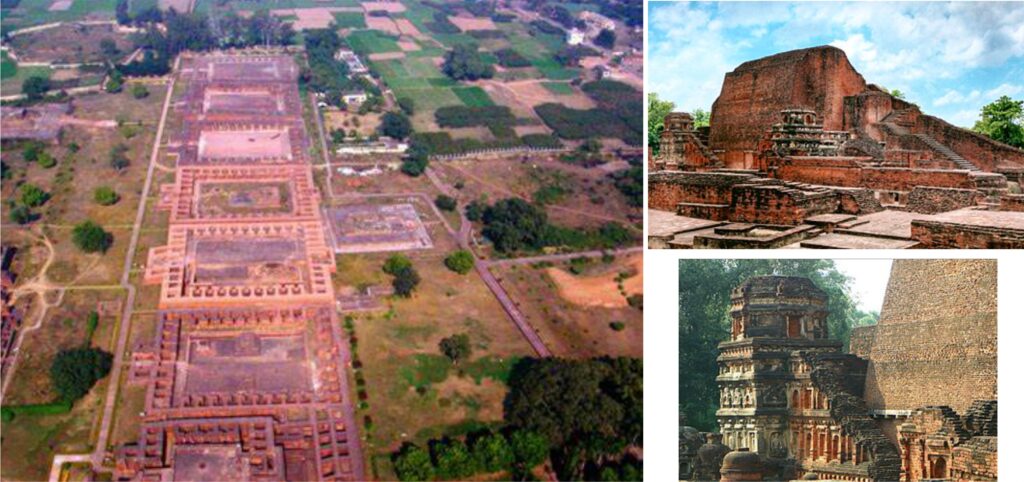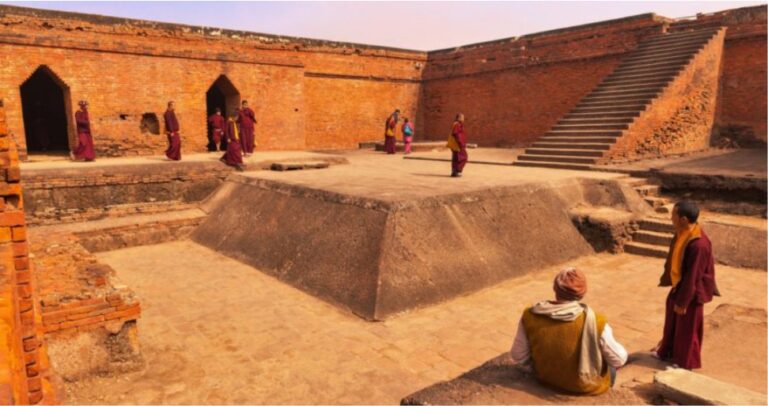![]()
Nalanda, pronounced as [naːlən̪d̪aː], stood as a beacon of knowledge in ancient Magadha, present-day Bihar, eastern India. Historians hail it as the world’s first residential university and one of the most significant centers of learning in antiquity. Located close to the city of Rajagriha, now Rajgir, and about 90 kilometers southeast of Pataliputra, known as Patna today, Nalanda flourished from 427 to 1197 CE. This period is often referred to as the “Golden Age of India.”
Foundation and Patronage
Nalanda’s origins trace back to the Gupta Empire era, and it garnered support from various Indian and Javanese patrons, both Buddhist and non-Buddhist. Over seven and a half centuries, it boasted a renowned faculty, including esteemed scholars of Mahayana Buddhism. Nalanda’s curriculum spanned six major Buddhist schools and philosophies, along with subjects like Vedas, grammar, medicine, logic, mathematics, astronomy, and alchemy. It also played a pivotal role in influencing East Asian Buddhism, with pilgrims like Xuanzang and Yijing carrying Sanskrit texts to China in the 7th century.
Cultural and Intellectual Significance
Nalanda contributed significantly to the development of Mahayana and Vajrayana Buddhism. Texts created at Nalanda, such as the Mahavairocana Tantra and Bodhisattvacaryāvatāra by Shantideva, left an enduring legacy. Despite potential damage from attacks, notably by Muhammad Bakhtiyar Khalji, Nalanda continued its operations for decades, if not centuries.
UNESCO World Heritage Site
Today, Nalanda stands as a UNESCO World Heritage Site, a testament to its historical and cultural importance.
Revival Efforts
In 2010, the Government of India took a significant step by passing the Nalanda University Bill to revive this iconic institution. A contemporary institute, Nalanda University, was established in Rajgir. It was designated as an “Institute of National Importance” by the Indian government, signifying its role in revitalizing the legacy of ancient Nalanda.
Location
Nalanda is situated approximately 16 kilometers north of Rajgir and about 90 kilometers southeast of Patna, well-connected to India’s highway network. It is also relatively close to Bodh Gaya, another prominent Buddhist site in Bihar.

Etymology
The name Nalanda has been attributed to various origins, including a serpent deity named Nalanda or the abundance of lotus stalks (nālas) in the area. Some Tibetan sources refer to it as Nalendra, possibly synonymous with Nala, Nalaka, or Nalakagrama mentioned in Tibetan literature.
History
Nalanda’s historical roots can be traced back to the 1st millennium BCE, closely associated with Rajagriha and the broader Magadha region. The early Buddhist texts mention Buddha’s visits to nearby areas, including Nalanda. Archaeological excavations suggest human settlement in the Nalanda region even before the birth of Buddha and Mahavira.
Visits by Renowned Pilgrims
The accounts of pilgrim monks like Faxian and Xuanzang provide invaluable insights into Nalanda’s past. Faxian’s visit around 400 CE did not mention the existence of a university, while Xuanzang’s visits in 637 and 642 CE depicted a thriving center of learning.
Foundation and Patronage
Nalanda’s formal history began in the 5th century, with monarch Shakraditya being credited as its founder. The Gupta emperors and their successors, including Harsha, generously supported Nalanda. Harsha’s contributions included grants of villages to sustain the institution.
Xuanzang’s Legacy
Xuanzang, during his stay at Nalanda, gathered a wealth of Sanskrit texts and relics, which he later brought back to China. He studied Yogachara and other subjects, leaving an indelible mark on the university.
Post-Gupta Period
Following the decline of the Guptas, Harsha remained a prominent patron. Inscriptions indicate grants of villages to Nalanda and its sustained growth. However, the precise number of monks and students at its peak remains a subject of debate.
Decline and Rediscovery
Nalanda met its demise in the early 13th century when it was ransacked and destroyed by Bakhtiyar Khalji. Although some sources suggest a makeshift revival, Nalanda eventually faded into obscurity. Its resurrection began in the 19th century with archaeological surveys and excavations by the Archaeological Survey of India.
Modern Revival
The Indian government’s enactment of the Nalanda University Bill in 2010 marked the institution’s resurgence. Nalanda University, an “International University of National Importance,” was established, carrying forward the legacy of its ancient predecessor.
Today, Nalanda serves as a significant tourist destination and a vital part of the Buddhist tourism circuit. Its rich history and revival efforts stand as a testament to the enduring spirit of knowledge and learning that the ancient institution embodied.
Reference:







